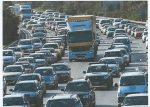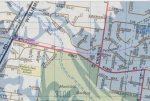CAR DEPENDENCY A DONCASTER HILL DILEMMA
TRAFFIC CONSULTANT’S REMARKS AND RECOMMENDATION
“A strategy based largely on car dependency (or existing travel patterns) to service future development is likely to return back to pre-1997 congestion levels on main roads through the study area. However, the performance of these scenarios is unsatisfactory in the PM Peak periods and as such demonstrates the need to accept a lower development density if travel behaviour is not changed”.
“The clearest statement about how to achieve the broad aims of the Strategy are to change people’s travel behavior by encouraging increased public transport use and to reduce the level of car dependency. Council policies and guidelines will form a key element of this task, with Council acting as an advocate of change in travel conduct”.
Preliminary work by consultants had based their reports on there being an integrated transport system for the centre which suggested that it would have all three modes of transport made available, the promise of a railway station on Doncaster Hill and an extension of the Tram line, however were never more than political skulduggery. As early as 2002,
Council were warned by Government that Buses would be the transport solution for Doncaster Hill and were told to stop tugging in other directions.
The railway line to Doncaster was officially abandoned in the 70’s and the railway easment north of King Street was sold for residential development more than ten years later. This did not deter Manningham from going full steam ahead with its high rise apartment strategy, (up to 5000 apartments when completed), the enormous expansion of Westfield, a Bunnings Store with 258 apartments above it and about 1000 more dwellings (2000 residents) when the redevelopment of the Eastern Golf Club Estate is completed.
The method of travel to work data below by Doncaster, (including Doncaster Hill), residents show an increase of only 73 more who traveled by bus since the 2011 census. There was a greater increase in rail commuters where an additional 117 accessed the train at Box Hill Station in the same period. Cycling to work increased from 7 in 2011 to 12 in the 2016 census. Hilly terrain and lack of safe dedicated paths were the main reasons for the such low numbers.

Analysis of Car ownership of the households in Doncaster (inc. Doncaster Hill) in 2016 compared to City of Manningham shows that 88.1% of the households owned at least one car, while 6.5% did not, compared with 90.7% and 4.0% respectively in City of Manningham. Of those that owned at least one vehicle, there was a larger proportion of persons who owned just one car; a smaller proportion who owned two cars; and a smaller proportion who owned three cars or more.
An alternative route from the eastern freeway to Doncaster Hill, via an exit ramp at Tram Rd, might have been possible had there been a wider area between the sound wall and the freeway. This would have improved traffic flow in Tram Road and removed the need for vehicles to use Eildon and Boyd Streets to access Tram Road from Elgar Road.
Members of RAIDID (Residents Against Inappropriate Development In Doncaster) have concerns about future traffic congestion in Doncaster Road and how vehicles will be able to enter the high rise apartment buildings without blocking traffic. This is because many of the buildings can only be accessed from the west by vehicles completing U turns at Council Street and Whittens Lane. There will also be a similar problem for east bound vehicles exiting from the same developments. It remains to be seen how the additional traffic, generated by the Westfield extension and the Bunning development, can be managed.





15 Comments
There is no accountability nor any incentive to get things right among the planning officers of the Manningham council and City planning. This is because they move on when their contracts expire or are not renewed either way they won’t be around when the traffic problem becomes critical.. Then there are the consultants who are perfectly willing to play ball with the desired conclusion for the sake of receiving repeat work, the cladding scandal is an example of that.
Apparently this huge Doncaster Hill development proceeded on the assumption, or more of hope, that a significant reduction in car dependency would be achieved. Unfortunately, despite all the programs to promote walking (One Step at a Time) and cycling to work, car dependency has actually increased in Doncaster compared to the use of buses which have remained stagnant at approximately 12.3% with car use and a car passenger outnumbering the use of buses by an increasing ratio of more than 5.33 to one (Mode of travel to work).
The previous plan for the centre, less than half the size of the present, was proposed mainly on the above trend but unfortunately never went ahead.
Manningham Council had considered, in order to ease congestion, removing car parking spaces from apartment developments all together which might have reduced traffic around Doncaster Hill and helped reduce traffic bank up on the Arterials but that would have made apartments almost impossible to sell hence Council’s quandary. Another reason why it would not have worked was because there are no parking areas anywhere in Doncaster that might have been utilised.
It will be hassle to move away and purchase elsewhere for those who have strong ties in the area and friendships made over a long period could fall away. It might not be practical for children to remain at the same school depending on where they move to. These idiots are forcing people to pull up stumps and leave the area, telling people who don’t like the developments they are building, to move away.
You can’t say that you weren’t warned of Manningham Council’s intentions. As early as 2002 they were holding meetings informing the community of how they were going to transform Doncaster into a “vibrant area.. a place to be” they said. But they never asked the people what type of redevelopment they preferred …they wanted high density at any cost. We sold up and left the area in 2009 before the Federal Investment Review Board (FIRB) opened the floodgates for overseas builders and investors to develop the inner city as well as Doncaster Hill and the surrounding residential strategy, prior to that the strategy was in trouble. The decision by FIRB resulted in the local major site owners selling to overseas developers. There is no local demand for vertical living on Doncaster Hill and nothing was built up till then.
If council had doubts about whether it could change travel behaviour on Doncaster Hill it needed to go for a lower density plan….that’s what the consult intimated. Not only is there greater car dependency today than ever before, and to make matters worse, Council have even higher density development in the pipeline, far beyond what had been presented to the consultant.
It is obvious that the consultants had concerns for their own reputation, otherwise they would not have inserted the following proviso.
“A strategy based largely on car dependency (or existing travel patterns) to service future development is likely to return back to pre-1997 congestion levels on main roads through the study area. However, the performance of these scenarios is unsatisfactory in the PM Peak periods and as such demonstrates the need to accept a lower development density if travel behaviour is not changed”.
There has been no change in the use of buses (12.3%), as a means of getting to work from Doncaster Hill, since the last census four years ago, while car use appears to have increased. This is well below the target of 20% in initial predictions. These early forecasts were based on there being more full time employment in the area.
Most of the high rise buildings on Doncaster Hill have included a large number of one bedroom studio apartments so as to to maximise total dwelling yield which means even more cars. The majority of these towers have at least half of their apartments at 50 sqm or less which are designed for singles or young couples, not empty nesters as council had predicted, who are more likely to need a motor vehicle to travel to work because there is very few employment opportunities in Manningham.
Clay Drive will play a major role in dispersing traffic from Doncaster Road when developments east of its border are completed. This would apply to vehicles traveling south and east by way of Tram Road to the eastern freeway. Manningham are not giving anything away at the moment but recent renovation to the left hand turn facility at Tram Road end was a clear indication of what’s in store for its residents.
Manningham Council turned its back on the wishes of its ratepayers, who wanted a plan that would fit in with infrastructure, but caved into the politicians and the greedy site owners and now their chickens have come home to roost with the Doncaster Hill area shaping up as a the planning disaster of the century. It is no surprise that they haven’t published the embarrassing statistics from the 2016 census on the council website.
You need a car to travel by Bus, sounds like a contradiction in terms you might say. But how do you expect to reduce car dependency when you need a car to travel to catch the City Bus at Park and Ride, more than a kilometer away on the border of Boroondara? There is no long term parking allowed in the narrow side streets leading up to the Bus routes and no all day car parking available at the Westfield Bus interchange. This could be one of the reasons why there has been no increase in Bus travel among the residents of Doncaster (including Doncaster Hill) in the last five years. And it might be that at least half the 12.3% who catch a Bus to work each day could be people who don’t own a car.
Your community should have expressed more interest at the planning stage by creating a meaningful dialogue with your council. It is not much use to anyone if you want to be involved at half time of the development instead of at the very beginning when suggestions from the public might have been useful. Having said that the strategy does appear to have been to rushed without an assurance of rail or at least a street car on the main road and your point about needing a car to catch a bus is spot on.
We heard a politician answering questions about improving transport to Doncaster on talk back radio. His response was “you already have access to the eastern freeway right on your doorstep plus a world class bus service”. This demonstrates just how out of touch our government is with the community. Neither political party is interested now that development of the Hill is well underway, a far cry from 2002 when our council could have put the strategy (the Government’s jewel in the crown of the activity centre program) on hold pending a firm undertaking for a railway to Doncaster Hill, but council never demanded it.
Fair for one fair for all! You won’t see any of the Manningham bureaucrats riding bikes, walking or catching a Bus. So why ask the rest of the population to leave their cars at home and travel by shanks’s pony because they think they are more important and need a car more than the rest of us.
A hold needs to be put on this, until Doncaster rail is built. There is too much traffic in the area already, and busses can’t cope with this number of people.